This is a level 3 and 4 number activity from the Figure It Out theme series.
Click on the image to enlarge it. Click again to close. Download PDF (362 KB)
divide numbers by 10
add decimal numbers
FIO, Level 3, Theme: Time Travel, Back to the Present, page 24
Copymaster of the time-point table
A classmate
This activity gives the students the opportunity to practise doubling numbers, dividing numbers by 10, and also adding whole numbers and decimals. (Parts of 100 years travelled will give decimal amounts for time points.) Because the students are working with large numbers, it is particularly important that they understand place value and that they add numbers in the correct columns (for example, adding ones to ones, tens to tens, hundreds to hundreds, and so on.) The students will need to be careful if they are using a calculator for this activity because most calculators display only
eight digits, whereas the total time points has nine digits (seven before the decimal point and two after it). This means that just adding the time points on a standard calculator will give an incorrect answer (for example, 1 400 197.8). If the students are using a calculator, they will need to find a way to work out the correct total, for example, adding the whole numbers first and then the decimals and then adding those two totals together without using a calculator.
You could begin the activity by asking the students to estimate what they think the total time points will be.
A strategy the students may find useful when adding up their time points is to look for combinations of numbers that add up to 10, 100, and so on, or patterns such as doubles that they are able to calculate easily. If they find adding decimals quite difficult, using an empty number line may help them, for example:
The students will gain approximately 1 400 000 time points. (The number of time points will vary depending on the current date.) As explained in the answers, they may choose one of the rewards that need fewer than 1 400 000 time points or they may like to negotiate with a classmate to combine time points and get a mini space waka together.
As an extension, the students could draw a timeline and plot on it all the destinations that the Space Waka has visited. They could also include the year they were born and any significant dates they know.
Answers to Activities
1.
2. Answers will vary. You may decide to combine your time points with your classmate’s to be able to get the mini space waka.


